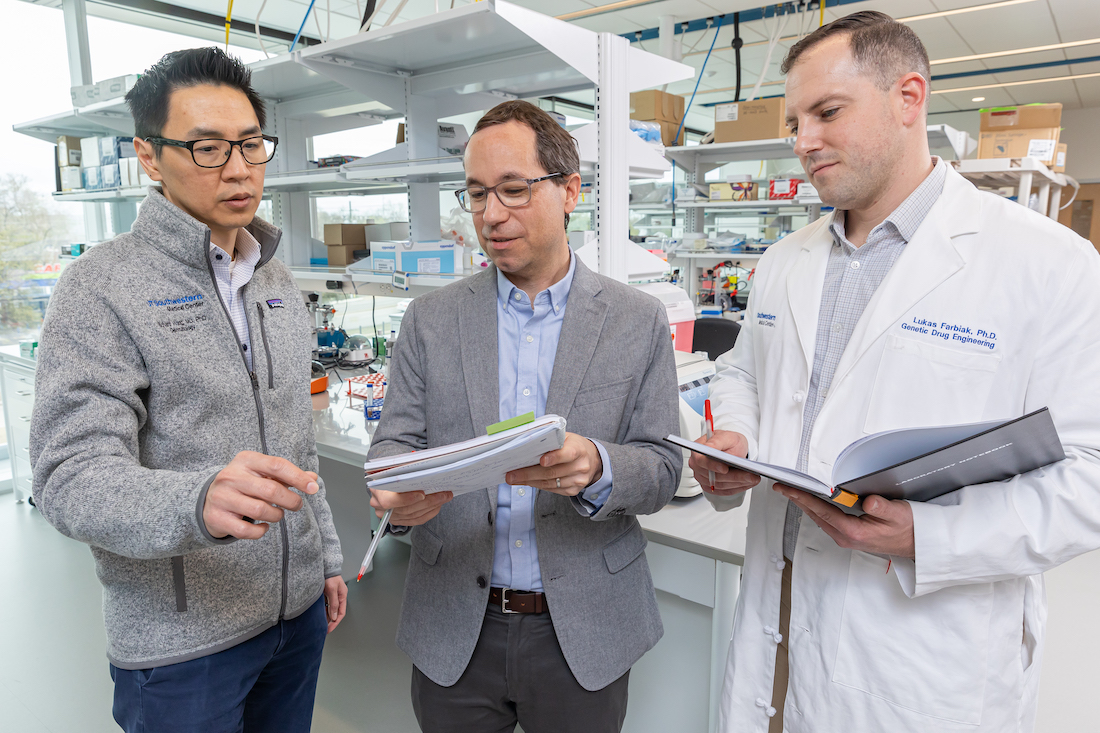Bioengineering the body to make its own medicine
Signal peptide added to messenger RNA induces cells to secrete therapeutic proteins into the bloodstream, UTSW study shows

DALLAS – March 13, 2024 – Delivering genetic material tagged with a cellular “ZIP code” prompted cells to secrete proteins or drugs into the bloodstream that successfully treated psoriasis and cancer in mouse models, UT Southwestern Medical Center scientists report in a new study. The findings, published in PNAS, could eventually lead to new therapies in which patients’ bodies produce their own drugs, avoiding the drawbacks of many intravenously administered medicines.

“Instead of going to the hospital or outpatient clinic frequently for infusions, this technology may someday allow a patient to receive a treatment at a pharmacy or even at home once a month, which would be a significant boost to their quality of life,” said study leader Daniel Siegwart, Ph.D., Professor of Biomedical Engineering and Biochemistry and co-leader of the Chemistry and Cancer Research Program at the Harold C. Simmons Comprehensive Cancer Center at UT Southwestern.
In 2020, researchers elsewhere developed a new type of vaccine that relies on messenger RNA (mRNA) – a single-stranded genetic molecule that cells use to produce a specific protein – to prompt an immune reaction against the virus that causes COVID-19. Billions of doses of these vaccines have been delivered successfully to people around the world with few side effects.
This effort is far from the first time that scientists have used genetic medicines – therapies in which genetic material is delivered to cells to produce a protein to replace one that’s missing or defective. Gene therapies are currently being investigated or used for dozens of diseases. However, Dr. Siegwart explained, the proteins produced by genetic medicines generally stay trapped inside cells. Because autoimmune and many other diseases cause systemic effects, inducing cells to secrete therapeutic proteins into the bloodstream could relieve symptoms throughout the body.
Toward this goal, Dr. Siegwart and his colleagues looked to signal peptides (SPs), genetic sequences that serve as cellular “ZIP codes” to direct proteins produced from genetic material to where they are needed. Although most known SPs direct proteins to organelles within cells, some – called secretory SPs – cause proteins to be secreted from cells into systemic circulation.
Dr. Siegwart and his colleagues isolated a piece of mRNA that produces secretory SP derived from a protein called Factor VII that is involved in blood clotting. Next, they attached this SP-encoding mRNA fragment to four different mRNA sequences that produced various proteins: a fluorescent protein called mCherry that could provide a visual readout on whether it was secreted from cells; a human protein involved in blood production called erythropoietin; a therapeutic protein called etanercept used to treat inflammatory diseases; and another therapeutic protein called anti-PD-L1 used to treat cancer. They then packaged these modified mRNAs into lipid nanoparticles and delivered them to cells growing in laboratory dishes. Their results showed that the cells secreted SP-tagged proteins made from these mRNAs into the surrounding liquid, whereas the proteins without the secretory SP remained inside cells that received mRNAs.
This observation inspired the researchers to examine whether the body could serve as a biofactory to produce and secrete therapeutic proteins. Indeed, when the researchers treated mice with psoriasis with the modified mRNA coding for etanercept, the psoriasis plaques in their skin were significantly decreased, as were molecular markers for inflammation. Similarly, when the researchers treated mice bearing two types of cancer with modified mRNAs coding for anti-PD-L1, tumor growth was significantly decreased, and the mice survived twice as long as those that were not treated.
Dr. Siegwart noted that using the body’s own machinery to make and deliver therapeutic proteins may help to overcome side effects and increase the efficacy of protein drugs that currently must be delivered by infusion. It could also decrease the hassle of having to receive frequent and sometimes lengthy infusions. Using this technology to produce these drugs within the body could eventually improve health and quality of life for patients with inflammatory diseases, cancers, clotting disorders, diabetes, and a range of genetic disorders, he said.
Other UTSW researchers who contributed to this study are Lukas Farbiak, Ph.D., Assistant Professor of Biomedical Engineering; Richard C. Wang, M.D., Ph.D., Associate Professor of Dermatology; graduate student researchers Amogh Vaidya, Erick Guerrero, Joshua Robinson, and William E. Miller; senior research associates Eunice E. Lee, B.S., and Xu Wang, Ph.D.; resident Elysha K. Rose, M.D.; and postdoctoral researcher Xizhen Lian, Ph.D.
This study was funded in part by a National Institutes of Health National Institute of Biomedical Imaging and Bioengineering grant (R01 EB025192-01A1) and the National Cancer Institute Cancer Center Support Grant (P30CA142543).
Dr. Siegwart holds the W. Ray Wallace Distinguished Chair in Molecular Oncology Research.
The University of Texas has filed patent applications related to the technology involved in this study that has been licensed to Signify Bio. More information, including author financial disclosures, can be found in the manuscript.
About UT Southwestern Medical Center
UT Southwestern, one of the nation’s premier academic medical centers, integrates pioneering biomedical research with exceptional clinical care and education. The institution’s faculty members have received six Nobel Prizes and include 25 members of the National Academy of Sciences, 21 members of the National Academy of Medicine, and 13 Howard Hughes Medical Institute Investigators. The full-time faculty of more than 3,100 is responsible for groundbreaking medical advances and is committed to translating science-driven research quickly to new clinical treatments. UT Southwestern physicians provide care in more than 80 specialties to more than 120,000 hospitalized patients, more than 360,000 emergency room cases, and oversee nearly 5 million outpatient visits a year.
